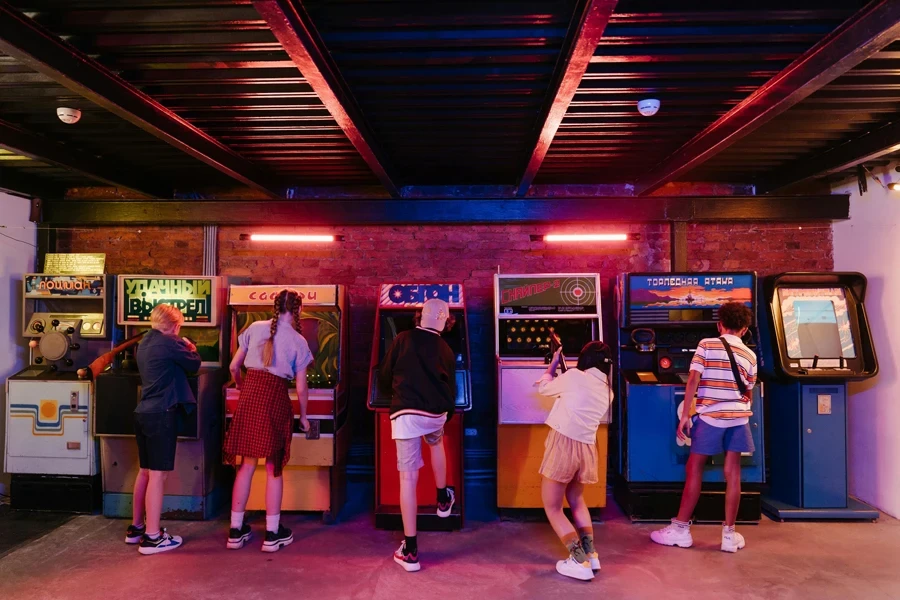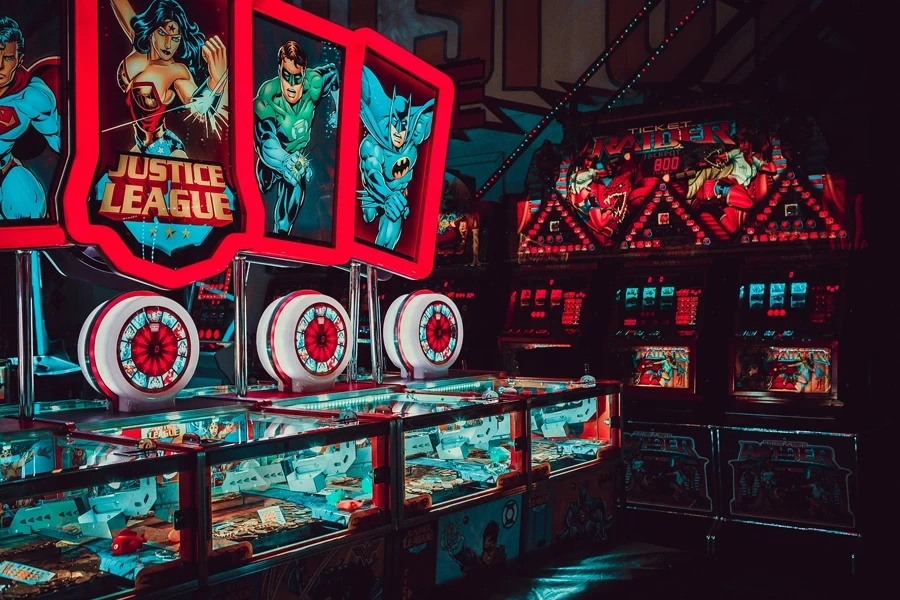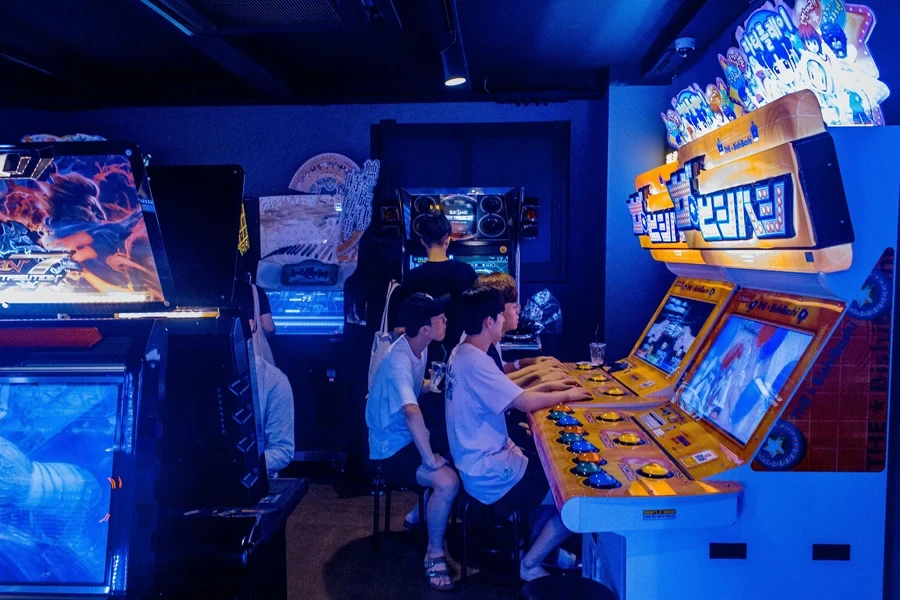Table of Contents
● Introduction
● Market overview
● Key design and material innovations
● Top sellers driving market trends
● Conclusion
Introduction
The world of coin-operated games is changing quickly by combining old-school charm with technology to effectively engage a wide range of players. This exciting field is expanding rapidly thanks to advancements in AR (Augmented Reality), VR (Virtual Reality), and AI (Artificial Intelligence), which are elevating the gaming experience and revolutionizing game development. In arcade gaming, key players such as Microsoft and Nintendo are leading the charge in this evolution by introducing concepts and exploring new possibilities. Furthermore, a significant change in the gaming industry is happening due to blockchain technology, which is enhancing game ownership and economies within games, making the gaming experience more captivating and rewarding for players. As the industry grows, becoming more attentive to sustainability and immersive gameplay experiences, the use of friendly resources and energy-efficient designs is becoming more popular. This piece discusses the existing market scenario, delves into design directions, and emphasizes key contributors influencing the direction of the future arcade gaming sector.
Market overview

The market for coin-operated games is on the rise and is expected to hit $14.07 billion by 2028, with a compound annual growth rate of 3.1% from 2024. This increase is fueled by advancements in technology and the growing fascination of consumers with engaging and immersive entertainment offerings. As reported by Adroit Market Research, the market was valued at around $12.44 billion in 2024, showing an upward trajectory.
Regional insights
North America stands out with a market share fueled by a long-standing love for arcades and healthy spending habits among its residents, as highlighted in the findings from Verified Market Reports that showed a contribution of around 35% to the market in 2023. The Asia Pacific region also plays a role primarily because of the deep-rooted enthusiasm for arcade gaming in nations like Japan and China, which have rich arcade gaming traditions. Europe closely follows suit, with a market presence observed in countries such as the UK, Germany, and France. Each area plays a role in the expansion of the market by showcasing its distinct consumer tastes and market behaviors that drive growth forward on a global scale. The emphasis on embracing cutting-edge gaming innovations and offering interactive entertainment choices are key drivers behind the success of the market in these regions.

Key design and material innovations
The world of coin-operated games is evolving rapidly due to advancements in design and technology materials. This includes the integration of augmented reality (AR), virtual reality (VR), and artificial intelligence (AI) to improve game experiences and make them more engaging for players by creating environments. Blockchain technology and nonfungible tokens (NFTs) are also changing how game ownership works by allowing the trade of unique digital items within games. There is also a shift towards sustainability in the industry as game creators are adopting eco-friendly materials and energy-efficient designs to reduce their environmental impact. These new advancements draw in a range of players and establish fresh benchmarks in arcade gaming.
Advancements in technology
The world of coin-operated games is being revolutionized by cutting-edge technology like augmented reality (AR) reality (VR) and artificial intelligence (AI). VR headsets such as Oculus Rift and HTC Vive take players into realistic virtual environments, offering an immersive experience that traditional arcade games can’t replicate, enhancing player engagement and creating more dynamic gameplay elements. AI technology enhances the capabilities of nonplayer characters (NPCs), creating tailored gaming experiences that add depth and excitement to games for players.

Integration of blockchain and NFTs
Blockchain technology is changing how game ownership and in-game economies work by introducing fungible tokens (NFTs). These tokens represent in-game assets that players can own securely and confidently engage in activities like buying and trading virtual items. This advancement has given rise to play-to-earn (P2E) models where players have the opportunity to gain real-world value through their gameplay efforts. For instance, games such as Axie Infinity utilize technology to allow players to acquire collectibles and trade digital creatures, which can result in significant earnings. This new feature boosts player involvement. It opens up fresh income opportunities for game creators based on Antier Solutions, which suggests that the growing popularity of NFT technology and decentralized gaming environments is revolutionizing how games are experienced and monetized.
Sustainability in design
The move towards sustainability is gaining importance in the world of coin-operated games these days. Companies that make games use friendly materials and energy-saving designs to lessen their environmental impact. For example, reusing plastics and sustainable metals in building games helps reduce waste. Moreover, they include parts like LED screens and processors with low power usage in game development. This shift is spurred by increasing consumer recognition about the environment and their desire for environmentally friendly products. As per reports from Verified Market Reports, focusing on sustainability helps the environment and boosts the appeal of arcade games to environmentally conscious customers.
Immersive gaming experiences
Advancements in both hardware and software have greatly improved the level of player engagement in arcade games by enrichening the experience for players involved in the gameplay process with features like high-quality displays and powerful sound systems alongside haptic feedback technologies that bring a more lifelike and captivating gaming experience to users.Play4Example haptic technology offers sensations through vibrations and movements that enhance interactivity and immersion in games. Several companies, such as DBOX Technologies, have started incorporating feedback into arcade games to replicate real-world effects like the sensation of a car crash or the kickback from firing a weapon. In VR arcades, too, you can engage in sensory experiences with full-body tracking and motion platforms that let you move around and interact with virtual worlds in a truly immersive way.
Top sellers driving market trends

In the coin-operated gaming sector, there are thriving companies and iconic games that drive trends and standards with fresh ideas and products. These companies are Microsoft, Sony Interactive Entertainment, and Nintendo, leading the pack by pushing limits in game creation and technological advancements. Popular titles such as “Fireteam Raven of Halo ” along with “Axie Infinity ” rake in substantial earnings, shaping the future landscape of the arcade gaming industry. Edge products that include virtual reality and blockchain technology are drawing in a broader range of users and enriching the gaming experience.
Leading companies
Microsoft, Sony Interactive Entertainment, and Nintendo play a role in influencing market trends within the coin-operated gaming sector. Microsoft has utilized its technological capabilities to improve the arcade gaming atmosphere. Their game, “Halo; Fireteam Raven ” delivers a cooperative shooting experience with advanced graphics and interactive gameplay. As per findings from Adroit Market Research, Sony Interactive Entertainment is recognized for its approach to incorporating virtual reality into arcade games, resulting in highly immersive experiences. Nintendo remains a pioneer in the gaming industry due to its dedication to game design and user experience, which sets them apart from others. They stand out by combining traditional and contemporary gaming features. An example of their innovation is in games like “Mario Kart Arcade GP,” which upholds their position in the market.
Popular games
Top-selling games influence the gaming industry by drawing in a wide range of players and establishing fresh norms for gameplay mechanics. One standout example is “Halo; Fireteam Raven,” created by Microsoft—an arcade hit that has entranced gamers with its engaging gameplay and top-notch visuals. Another noteworthy title is “Axie Infinity,” which has shaken up the arcade scene by incorporating blockchain tech and NFTs that enable players to possess and exchange in-game items. According to a Medium.com report, these games bring in much money. Shape the direction of upcoming games by establishing demanding benchmarks for creativity and player involvement.
Innovative products

In the evolving arcade industry, innovative products are constantly reshaping the landscape with their cutting-edge features and enhanced gaming experiences. Sega Sammy Holdings recently introduced “Sega World Drivers Championship,” a game combining racing elements with state-of-the-art virtual reality features to provide players with a truly immersive experience. Another standout product is Bandai Namco Entertainment’s “Taiko no Tatsujin; Rhythmic Adventure Pack,” designed for the Nintendo Switch and praised for its captivating gameplay and clever incorporation of rhythm-based challenges. According to Adroit Market Research reports, there is a rise in the popularity of VR-based games such as “Virtual Rabbids,” along with the incorporation of cutting-edge motion technology in arcade machines, leading to the emergence of trends and drawing a broader audience.
Conclusion
The coin-operated games market is poised for growth due to rapid technological advancements and changing consumer tastes. Advancements in augmented reality (AR), virtual reality (VR), and blockchain technology are improving the gaming experience and drawing in a broader audience while introducing new revenue streams. Leading companies such as Microsoft, Sony Interactive Entertainment, and Nintendo spearhead these innovations by exploring new horizons in game development and player interaction. The gaming industry is constantly bringing in fresh and thrilling experiences for gamers while also opening up profitable business prospects. The market for coin-operated games presents an encouraging environment, with an estimated market worth of $14.07 billion expected by 2028 and a compound annual growth rate of 3.1%.




